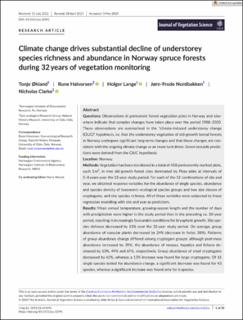| dc.description.abstract | Questions Observations in permanent forest vegetation plots in Norway and elsewhere indicate that complex changes have taken place over the period 1988–2020. These observations are summarised in the “climate-induced understorey change (CIUC)” hypothesis, i.e. that the understorey vegetation of old-growth boreal forests in Norway undergoes significant long-term changes and that these changes are consistent with the ongoing climate change as an important driver. Seven testable predictions were derived from the CIUC hypothesis. Location Norway. Methods Vegetation has been monitored in a total of 458 permanently marked plots, each 1 m2, in nine old-growth forest sites dominated by Picea abies at intervals of 5–8 years over the 32-year study period. For each of the 52 combinations of site and year, we obtained response variables for the abundance of single species, abundance and species density of taxonomic–ecological species groups and two size classes of cryptogams, and site species richness. All of these variables were subjected to linear regression modelling with site and year as predictors. Results Mean annual temperature, growing-season length and the number of days with precipitation were higher in the study period than in the preceding ca. 30-year period, resulting in increasingly favourable conditions for bryophyte growth. Site species richness decreased by 13% over the 32-year study period. On average, group abundance of vascular plants decreased by 24% (decrease in forbs: 38%). Patterns of group abundance change differed among cryptogam groups: although peat-moss abundance increased by 39%, the abundance of mosses, hepatics and lichens decreased by 13%, 49% and 67%, respectively. Group abundance of small cryptogams decreased by 61%, whereas a 13% increase was found for large cryptogams. Of 61 single species tested for abundance change, a significant decrease was found for 43 species, whereas a significant increase was found only for 6 species. Conclusions The major patterns of change in species richness, group species density and group abundance observed over the 32-year study period accord with most predictions from the CIUC hypothesis and are interpreted as direct and indirect responses to climate change, partly mediated through changes in the population dynamics of microtine rodents. The more favourable climate for bryophyte growth explains the observed increase for a few large bryophyte species, whereas the decrease observed for small mosses and hepatics is interpreted as an indirect amensalistic effect, brought about by shading and burial in mats of larger species and accelerated by reduced fine-scale disturbance by microtine rodents. Indirect effects of a thicker moss mat most likely drive the vascular plant decline although long-term effects of tree-stand dynamics and former logging cannot be completely ruled out. Our results suggest that the ongoing climate change has extensive, cascading effects on boreal forest ecosystems. The importance of long time-series of permanent vegetation plots for detecting and understanding the effects of climate change on boreal forests is emphasised. | en_US |

